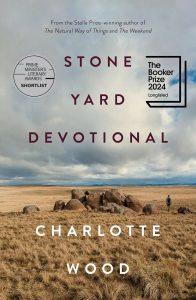I very nearly broke my rule and gave up reading this book half-way through. I am glad I didn’t, because it offers valuable challenges for reflection. Stone Yard Devotional is pitched as a novel, by Charlotte Wood, but it’s many other things as well. It’s like a journal, of someone on a long search for self, as well as cryptic insights into rural and religious life in the years of Covid restrictions. Still, I found myself often wondering, ‘Where is this going?’ Later, I came to see that is in fact the point!
 The narrator is a woman in later life, perhaps sixty years of so, who has chosen to engage with a very small convent of sisters, even though she is unsure about anything she might call ‘faith’. She visits, and later joins, the community. There is a sense that she has left a partner and family some time before, but this is not clear. Who they are, or where they are, is unclear in a way. The town nearby is simply referred to as ‘our town’. These ambiguities invite us to find our own lives and experience in this story.
The narrator is a woman in later life, perhaps sixty years of so, who has chosen to engage with a very small convent of sisters, even though she is unsure about anything she might call ‘faith’. She visits, and later joins, the community. There is a sense that she has left a partner and family some time before, but this is not clear. Who they are, or where they are, is unclear in a way. The town nearby is simply referred to as ‘our town’. These ambiguities invite us to find our own lives and experience in this story.
Several things dominate the narrative. A mouse plague creates appalling conditions for the community. The narrator is one of a few persons responsible for the daily emptying of traps and burial of dozens of dead animals. Eventually a farmer-neighbour, known to the narrator since school days in the nearby rural town, assists with a machine digger, to create burial trenches.
This gruesome aspect provides the backdrop for another equally weird element. A member of the religious order had at one point travelled to another country, in South-East Asia, where her mission work was not appreciated by some powerful figures, and she disappeared, presumed dead. Now, after many years, her remains have been found, and the sisters arrange for them to be brought to the convent. When they do finally arrive, another former member of the community accompanies them. She too is known to the narrator from school days. She has a deeply sad story of childhood public abuse by her own mentally ill mother. She, Helen, remains at a distance until very late in the story.
Strangely, the coffin containing the remains is kept in the one ‘good’ room of the house, where no mice have penetrated. Several of the sisters sit with the coffin for long periods, seeking some resolution of their grief and separation. It is unclear whether they will be allowed to bury the remains on their own property.
This story has so many profound levels of insight. One of these concerns the search for some meaning in life, through engagement or re-engagement with a form of religion long since abandoned. The narrator respects the sisters and to a degree joins them—it is unclear whether she has actually become one of them or is simply a welcome assistant in their shared life. But through her work she finds consolation and meaning. One day, for example, she reflects upon the pleasure she finds simply in sweeping the yard, but then also finds a much deeper meaning for herself. Sweeping the bricks allows her also to get to something ‘underneath’ her own life, specifically the loss of both her parents when still very young.
The deep satisfaction of swept pavers and bricks, their stern beauty and restored order. As I swept it came to me that my inability to get over my parents’ death has been a source of lifelong shame to me. I used to think that time, adulthood, would clean it away, but no. It recedes sometimes but then it returns and I’m eternally stuck; a lumbering, crying, self-pitying child. The fact of grief quietly making itself known, again and again.
Here is the heart of the stone yard devotional: it appears to be a story of some weeks and months of daily living and practical tasks, but beneath it all there are many tales of grief, largely unresolved, in almost everyone’s life. The narrator and the somewhat estranged sister Helen both have childhood accounts of such grief and eventually find something to share, first when they bathe apart and yet together, in the river, and later when Helen is leaving, they finally share some of the story of her mother’s incarceration in a ‘mental home’.
Our narrator also recounts some of her own mother’s strange life and early death:
Even when barely conscious, my mother received her tearful visitors with a pale, transcendent solemnity, growing smaller and more skeletal there in her bed, but also enlarging in some way—I suppose I mean spiritually. She seemed to rise, even as she shrank. I could never have said this to anyone. I don’t know what has caused me to want to say it now.
This is the heart of the ‘devotional’, a strange and rarely used term these days. Here a mature woman, and a long-established community, are seeking somehow to come to grips with death, our mortality, but not as concepts or doctrines, philosophical categories. No, here death is engaged with through specific instances and experiences. Some of these are immediate, indicated by the mouse plague. Others have been ‘there’, with them, for a long time, but are not buried—symbolised by the returned remains. But most powerfully, it is the memories, the relationships, and the challenges of rituals long upheld but for most of them no longer immediately meaningful: here is the matter of mortality and meaning, intertwined. It is the question of faith amidst life itself. What may we hold onto, as we deal with all that is past and passing?
The ‘stone yard’ is simply one of the areas of the property. It is a place to bury things, and yet also a place of new beginnings and old meanings found afresh. It is where we live.
There’s an interesting biblical image of a ‘redeemer’ figure who is ‘a man of sorrows and acquainted with grief’. Christians have often appropriated this image to relate to Christ, but it belongs in the Hebrew Bible traditions from a much earlier period (See Isaiah 53. v.3). It is surely true that for most of human history and many communities still, grief and suffering such as are considered here are not unusual but common, and learning to live with these realities is a crucial dimension of life. To live well into adulthood and even older age without needing to engage these issues may seem to be a fortunate life, but perhaps it is not. Perhaps the ‘stone yard devotional’ allows us to come to these insights and realities, however and wherever we are in life. It’s best not to give up on it half way through!
